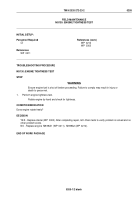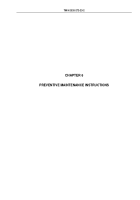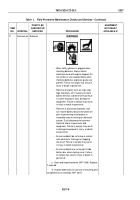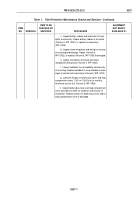TM-9-2320-272-23-2 - Page 335 of 1417
TM 9-2320-272-23-2
0206
0206-2
CORROSION PREVENTION AND CONTROL (CPC)
Corrosion Prevention and Control (CPC) of Army materiel is a continuing concern. It is important that any
corrosion problems with this item be reported so that the problem can be corrected and improvements can be
made to prevent the problem in future items.
Corrosion specifically occurs with metals. It is an electrochemical process that causes the degradation of
metals.
It is commonly caused by exposure to moisture, acids, bases, or salts. An example is the rusting of iron.
Corrosion damage in metals can be seen, depending on the metal, as tarnishing, pitting, fogging, surface residue,
and/or cracking.
SF Form 368, Product Quality Deficiency Report should be submitted to the address specified in DA PAM
750-8,The Army Maintenance Management System (TAMMS) Users Manual.
PMCS COLUMN DESCRIPTION
The preventive maintenance checks and services for which you are responsible are provided in the PMCS tables.
The checks and services listed are arranged in logical order.
The following columns are left to right on the PMCS schedule:
Item Number
. Provides logical order for PMCS performance and is used as a source number for DA
Form2404, on which your PMCS results will be recorded.
Interval.
Indicates when check or service is to be performed.
Item To Check or Serviced. Lists the system, common name, or location of the item to be inspected.
Procedure.
Provides instructions for servicing, inspection, replacement, or adjustment and, in some cases,
having an item repaired at a higher level. If a defect is found, repair, fill, replace, or adjust as needed.
Equipment Not Ready/Available If.
Provides information for deadlining a vehicle when checks or services
reveal a defect or deficiency of a component(s) of the vehicle.
FLUID LEAKAGE
It is necessary for you to know how fluid leakage affects the status of the (enter component/equipment
name). Following are types/classes of leakage you need to know to be able to determine the status of the (enter
component/equipment name). Learn these leakage definitions and remember - when in doubt, notify your
supervisor. Equipment operation is allowed with minor leakage (Class I or II). Consideration must be given to fluid
capacity in the item/system being checked/inspected. When in doubt, notify your supervisor.
When operating with Class I or II leaks, continue to check fluid levels as required in the PMCS.
Class III leaks should be reported immediately to your supervisor.
Wetness around seals, gaskets, fittings, or connections indicates leakage. A stain also denotes leakage. If a fitting
or connector is loose, tighten it. If broken or defective, report it.
Class I.
Leakage indicated by wetness or discoloration not great enough to form drops.
Class II
. Leakage great enough to form drops, but not enough to cause drops to drip from item being
checked/inspected.
Class III.
Leakage great enough to form drops that fall from the item being checked/inspected.
END OF WORK PACKAGE
Back to Top




















